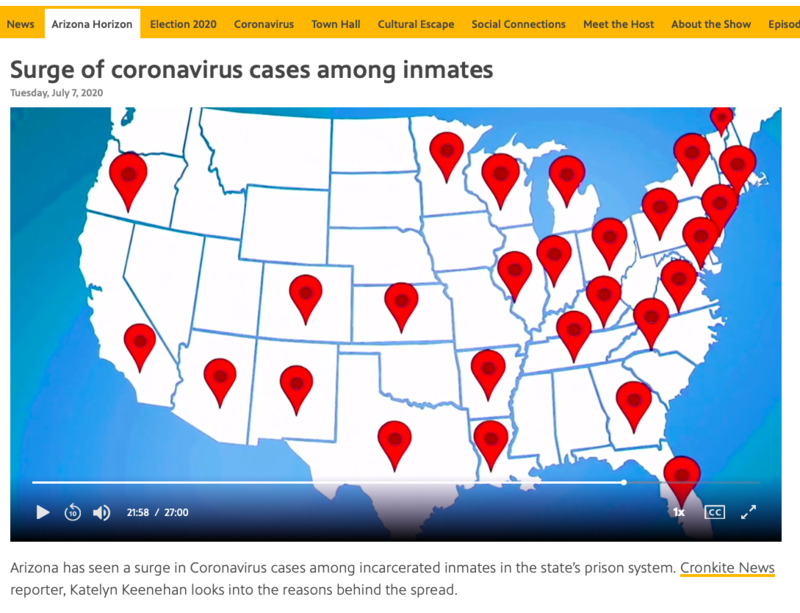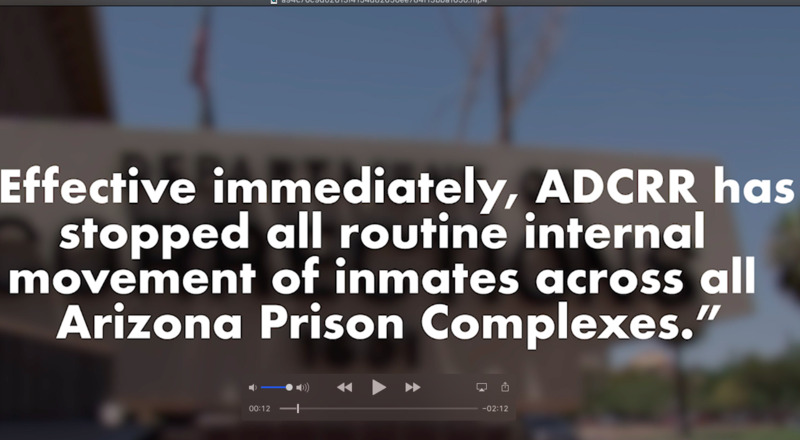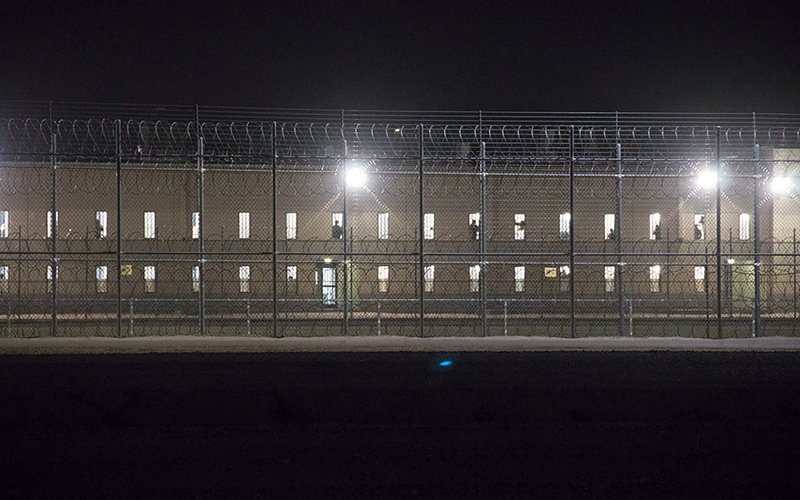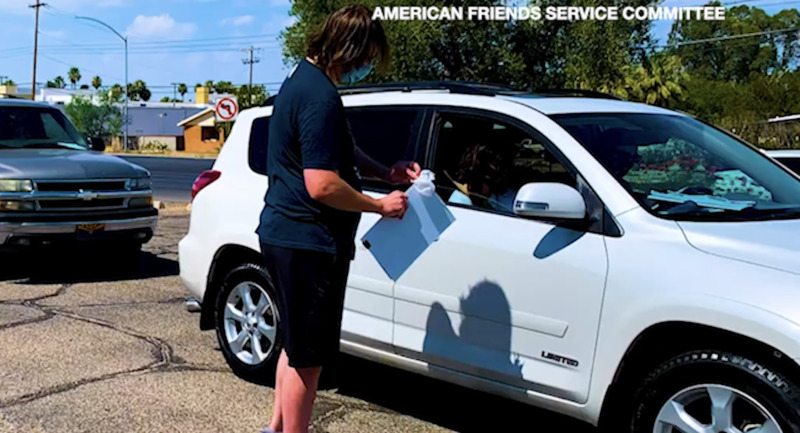Incarceration Stories
‘They’re scared’: A look inside the COVID-19 crisis in Arizona prisons
By Katelyn Keenehan | Luce Foundation: Southwest Stories Fellowship
As COVID-19 began to spread across the Southwest in March, lawyers representing incarcerated Arizonans reported “unsanitary conditions,” “inadequate medical staffing and treatment” and a “failure to take strong and sensible precautionary measures” in state prisons.
The combination left prisoners “highly vulnerable to outbreaks,” the attorneys wrote in a letter to the state before asking a federal judge to intervene. COVID-19 can spread swiftly in crowded indoor spaces and among individuals with chronic health problems.
More than three months later, complaints of insufficient safety measures and subpar medical care continue to plague Arizona prisons.
And as hundreds of inmates and corrections officers test positive for the virus, justice reform advocates and others with ties to the correctional system worry the state is running out of time to prevent an even more dangerous surge in cases.
“(Inmates) are scared,” said Jared Wagoner, who was incarcerated in the Yuma prison’s Cibola Unit until June 8. He cited close quarters, insufficient testing and indifferent medical staff as ongoing obstacles.
“They’re scared that their two-year sentence is going to become a life sentence,” Wagoner said.
‘We could never get a straight answer’
Arizona has one of the highest incarceration rates in the country, with more than 40,000 people in prisons.
Yuma is among the worst prison complexes in the state terms of COVID-19 infections. As of early July, officials had tested more than 500 of the facility’s 4,700-plus prisoners for the virus, with nearly one in five testing positive.
“People had tested positive out of every single dorm on the yard,” Wagoner said. With prisoners sharing bathrooms and spaced just three feet from each other while in their cells, that meant nearly everyone had likely been exposed, he said.
The nearly 3,000-inmate Kingman complex, in Golden Valley, also experienced a smaller-scale COVID-19 outbreak. Five of 15 people tested for the virus came back positive in early July.
Deborah North, whose husband is incarcerated at Kingman, said family members had to piece together many of the details themselves, as they were mostly kept in the dark. The state Department of Corrections, Rehabilitation and Reentry also declined a media request for an interview.
“I am in a lot of Facebook groups with people that have relations inside Kingman,” North said. “If you don’t hear from your loved one even for a day, then the signal goes out, and everybody questions what is going on.”
North’s husband is 78, which puts him in the age group most vulnerable to the virus. Due to the tight living quarters and thin hallways, maintaining six feet of social distance is out of the question for him, she said. Six inches is more realistic as inmates line up to get food or medication.
For months, prisoners lacked access to a basic tool that could’ve mitigated infection risks in close quarters — masks — despite being put to work making face coverings for prison staff as early as April 7. Masks were not mandatory for staff until June 12, when ADCRR director David Shinn issued a notice requiring them on the complex premises.
Face coverings help block the respiratory droplets produced when an infected person coughs, sneezes or talks — the primary way the virus spreads, according to the U.S. Centers for Disease Control and Prevention.
At the Yuma complex, where Wagoner was incarcerated, “we asked the warden why we weren’t getting masks, and then the warden would tell us to address medical (staff),” he said. “Then, medical would tell us to ask the warden and we could never get a straight answer.”
At the Kingman complex, officials started providing three masks a week per inmate after prisoners began trading the few masks they had for other goods, according to North.
“I think they wanted to reduce how much they had become a commodity,” she said.
It wasn’t until June 29, after months of pressure from prisoners, their families and other advocates, that Gov. Doug Ducey announced all incarcerated Arizonans would have access to masks by the end of the week.
‘Nobody ... has been able to get a test’
Testing access has proved to be another persistent problem.
Though corrections officials said via email that they “separate any inmates who exhibit flu-like symptoms from the general population for monitoring and appropriate follow-up care,” it’s not clear how severe a prisoner’s symptoms must be in order to be tested and separated from the general population.
In Yuma, inmates who reported symptoms were turned away without receiving a test, Wagoner said.
“All the medical (staff) told them was that they were dehydrated, and to go back to the dorm and drink water,” he said.
At the Kingman complex, “nobody in the runs (dorms) that my husband is near to has been able to get a test,” North said. “Not a single one.”
North’s husband has faced ongoing challenges when trying to receive medical care, she said, despite living in the complex’s medical unit. Prisoners have long alleged medical services in state prisons fall short: Despite settling a class-action lawsuit over the matter in 2014, the state has been fined millions for failing to comply with the terms outlined in the settlement.
“A lot of the medical staff treat them as subhuman ... and that was true before COVID,” North said.
The state also does not require infected corrections staff to report their COVID-19 status; however, it does allow them to self-report if they desire. The self-reported staff numbers can be found on the ADCRR COVID-19 dashboard.
Precautions not evenly implemented, families say
Throughout the pandemic, state corrections officials have insisted they’ve instituted several precautionary measures to protect inmates from the virus, such as suspending visitation, halting inmate transfers to avoid cross-contamination, and providing bars of body soap upon request.
But prisoners and their families say the precautions have been implemented unevenly and irregularly.
At state-run facilities like Yuma, for instance, officials implemented one 15-minute video visit a week per inmate, in addition to two free phone calls. But at the Kingman complex, operated by GEO Group, video visits have never been an option.
Prisoners do receive soap, but the bars are the size of two quarters. Inmates are expected to use them to wash their hands, bunks and bathrooms.
When the American Friends Service Committee of Arizona, Arizona Attorneys for Criminal Justice and the Reframing Justice Project gathered masks, soaps, gloves, tampons, and other personal hygiene equipment for prisoners, the state would not accept them.
And though officials did temporarily stop transferring inmates from facility to facility — a strategy used to meet bed-occupancy contract requirements — it appears to have resumed transfers in recent weeks.
“We have done prison reform rallies by the Douglas facilities, and can see the buses pulling in full of people, ” North said.
At least 421 prisoners at 13 of the state’s 16 facilities have tested positive for COVID-19, according to the state, and at least 226 staffers have reported positive results.
COVID-19 outbreaks threaten migrant, officer safety at cramped detention centers, advocates say
By Jessica Myers | Luce Foundation: Southwest Stories Fellowship
And quarantine, for him, has meant solitary confinement. Andrés gets 20 minutes a day outside his cell, Chávez said, which he first uses to call his wife of 29 years and family. He uses the remaining time to shower.
“Any normal person would get depressed in quarantine, locked up for almost 24 hours a day,” Chávez said in Spanish. “For those of us on the outside, it’s different. But for the person that’s inside, it’s enough to drive you crazy.”
La Palma, which can house up to 3,060 detainees, is one of two privately run Immigration and Customs Enforcement facilities in Eloy, Arizona. The other, Eloy Detention Center, can hold up to 1,456 people.
At the end of July, there were 252 positive COVID-19 cases at Eloy and 108 positive cases in La Palma. Among the roughly 4,000 detainees who had tested positive for the virus as of late July, ICE data showed Eloy Detention Center had the third-highest number of positive cases in the country, after facilities in Washington, D.C., and Texas.
Migrant rights activists suspect official numbers don’t tell the full story — given the lack of comprehensive testing at detention facilities, they say, it’s likely COVID-19 has sickened or infected many more detainees. But officials from ICE and CoreCivic, which owns and operates both Eloy facilities, have defended their handling of the pandemic, saying they’ve relied on federal guidelines to protect employees and “those entrusted to our care.”
Lawsuits filed throughout the country argue those measures have fallen short. Migrant advocacy groups say the facilities’ poor ventilation and small, enclosed spaces put detainees — many of whom are seeking asylum in the United States — at high risk of contracting COVID-19.
They contend release is the “only appropriate remedy.”
Yvette Borja, a border litigation attorney for the American Civil Liberties Union of Arizona, said that if the lawsuits don’t work, “everybody that cares about immigrants is going to need to think creatively about other ways to get folks out.”
“The medical care in both of the facilities has long been documented as subpar,” she said. “If you can’t handle the regular flu, there’s absolutely no way that you can handle coronavirus.”
Advocates allege ‘abysmal’ conditions
Borja said “deadly” conditions at Eloy and La Palma predate the COVID-19 pandemic. “Diseases that we have long had under control” have sickened detainees, she said, citing the 2016-2017 measles outbreak at Eloy.
“The conditions now could only have worsened from an already very abysmal point,” she said.
In June, the ACLU — along with the Florence Project, an Arizona nonprofit that provides free legal and social services to those in detention, and Phoenix law firm Perkins Coie — filed a federal lawsuit on behalf of 13 detainees at Eloy and La Palma.
It’s one of more than 100 such legal challenges filed in the U.S. since mid-March, according to a report published by the Lawfare Institute in cooperation with the Brookings Institution.
In the Eloy lawsuit, attorneys argued that detainees faced “imminent risk, including severe illness or death” in ICE custody. The legal complaint aimed to “build up the fact record and really prove to this judge that the only appropriate remedy for ICE’s constitutional violations is release of these petitioners,” Borja said.
“The conditions of confinement do not allow for social distancing within cells, detainees interact in common spaces, employees move throughout the facility working on multiple units, and detainees are not required to follow recommendations about masks and social distancing in common spaces,” the complaint said.
“Accordingly, as the COVID-19 global pandemic spreads, Petitioners are trapped in a ‘tinderbox scenario’ where rapid outbreak is extremely likely, and extremely likely to lead to deadly results.”
Since the start of the pandemic, LGBTQ migrant-rights organization Trans Queer Pueblo has received three letters from La Palma detainees describing similarly dangerous conditions.
“When we send (a medical) request, it takes four to 15 days for them to come and check us, and they only prescribe us water,” an April 30 letter signed by 32 high-risk detainees says in Spanish. “No matter the illness, they send us to drink water.”
A May 18 letter signed by 29 migrants shared the confusion and frustration of detainees trying to pinpoint where COVID-19 cases existed within the facility.
“From our heart, we ask for help,” the letter said. “We are human beings. We do not want to die here, please.”
Chávez also recalled her husband complaining that officers never provided “explanations or information” about the spread of the virus, even when detainees directly requested it.
Immigration and Customs Enforcement detainees gather in the yard at the Eloy Detention Center in this 2017 photo. As of Aug. 5, ICE reported 248 detainees at Eloy had tested positive for COVID-19, the third-highest among ICE facilities nationwide. (File photo by Charlene Santiago/Cronkite News)
“He realized what was going on himself,” she said. “There were rumors that people were feeling sick. A few days later, they closed the kitchen. Then a few days after that, he saw that one of the guards was sick — he saw him throwing up in a bag.
“He would hear rumors about, ‘This or that person is sick,’ and then they would put them in quarantine.”
Chávez said Andrés has never felt ill himself, despite being quarantined twice. But it’s impossible to know for sure whether he was ever infected.
He told Chávez detainees have never had access to COVID-19 tests. Officers simply release them from quarantine after 12-14 days if detainees aren’t showing symptoms, she said.
Information ‘slow and inconsistent and filled with holes’
Tom Jawetz, vice president of immigration policy at the Center for American Progress, said the information shared with the public also has been “slow and inconsistent and filled with holes.”
He called the Department of Homeland Security’s ability to provide accurate test rates in ICE facilities “lacking” and said data released by the agency fails to paint a full picture.
“We’ve seen instances of individuals who, once they’ve been transferred to the hospital, have no longer been reported as being in ICE custody, because ICE has essentially released them to the custody of the hospital,” Jawetz said.
He said ICE data on detainee cases doesn’t include those who have tested positive but are no longer in isolation or under monitoring, either.
“There are a lot of problems with how ICE is releasing information regarding these facilities that makes it very hard to even understand exactly what is going on,” he said.
ICE’s COVID-19 page detailing employee cases also appears incomplete and outdated. It shows one confirmed ICE employee case at Eloy — a data point from June that excludes CoreCivic staff members.
Ryan Gustin, a CoreCivic spokesman, said 128 CoreCivic employees at the Eloy facility tested positive for COVID-19 on July 1-2, about 40% of employees there. By July 27, he said, 159 of the center’s roughly 315 employees — about half — had tested positive.
Since then, 139 of those employees have recovered and been cleared for work. At La Palma, 28 CoreCivic staffers have tested positive, and 27 have recovered and received medical clearance, he said.
Gustin dismissed claims about understaffing made by detainees and employees to NBC News last month as “patently false.”
“(Eloy Detention Center) has been staffed appropriately throughout the pandemic,” he said via email. “Part of our COVID-19 comprehensive planning includes contingencies to employ staff from other facilities from around the country with lower COVID-19 impacts to support facilities that may have higher COVID-19 impacts.”
He also said CoreCivic medical personnel are on site 24/7 at La Palma.
Officials: Centers taking health and safety ‘very seriously’
Representatives from both ICE and CoreCivic said they relied on CDC recommendations for cleaning and disinfection to minimize the spread of infection at detention centers.
Those recommendations include disinfecting shared surfaces and equipment; providing soap, paper towels and alcohol-based sanitizer; implementing guidelines for personal protective equipment; and encouraging social distancing.
The facilities also have a “Coronavirus Medical Action Plan” in place that includes isolating high-risk individuals as needed conducting “appropriate testing” with aid from state and local health departments and promoting “regular hand hygiene, respiratory etiquette (coughing or sneezing into a sleeve or tissue), and avoiding touching one’s face,” Gustin said.
Staff and detainees all received two surgical masks in early April, followed by two cloth masks that “may be laundered during weekly laundry exchanges” and replaced upon request, he said. And facilities screen employees for symptoms before they can enter.
“We are fully cooperating with public health authorities and other oversight agencies,” Gustin said via email.
Yasmeen Pitts O’Keefe, an ICE spokeswoman, said the agency takes “the health and safety of its detained population and facility staff very seriously.”
Chávez said her husband’s accounts don’t match that narrative, however.
Early on, he reported making a mask out of the sleeve of his shirt for protection, which a guard confiscated and threw away. She said he received only one mask from officials later, which he has had to use over and over.
She also said Andrés told her it seemed detention officers had disregarded several health and safety rules in recent weeks.
“My husband told me it’s clear the guards don’t care anymore, because they don’t even wear masks anymore,” she said. “He said, ‘There’s a holding cell with a bunch of infected (detainees) — guards go to that cell and then come to ours. They could infect us.’”
Chávez said she has felt “the same worry, desperation day and night” since the day Andrés was detained more than six months ago.
In some ways, it’s even worse now, she said: Before the pandemic, their children could visit Andrés and at least let her know he looked OK.
“Since they got rid of visitation, they haven’t been able to see him, and my worrying has gotten worse,” she said. “The anxiety is huge.”





